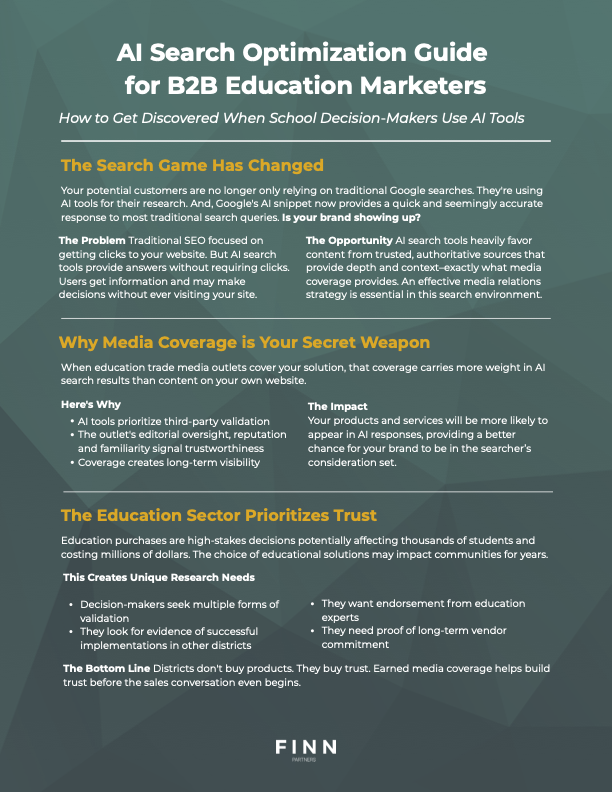News and Insights
Strategic Guide for AI in Education Marketing: The Hidden Power of Media Relations
July 23, 2025
How earned media is becoming the secret weapon for visibility in an AI-driven search landscape
Executive Summary
The landscape of education products and services procurement research has fundamentally shifted. As Chief Technology Officers and other school district administrators increasingly rely on AI-powered search tools to evaluate vendors and solutions, a surprising truth has emerged: traditional media relations strategies are more valuable than ever for mastering AI in education marketing.
Earned media coverage now serves as a primary fuel source for AI search algorithms, giving organizations with strong media relations programs a significant competitive advantage in a crowded education marketplace.
A New Reality: AI Search is Reshaping How Your Prospects Find You
Education procurement has always been high-stakes and high-trust. When administrators are selecting solutions that impact thousands of students and cost millions in taxpayer dollars, every decision carries enormous weight. The pandemic only heightened this reality, as parents gained visibility into their children’s educational experiences and began demanding greater accountability—and alignment—from school systems.
As an education marketer, you face an additional challenge: the tools your prospects use to research and evaluate vendors have fundamentally changed. AI-powered search results now appear at the top of Google searches, providing seemingly authoritative answers that can make or break your chances before a decision-maker ever visits your website.
The critical insight: AI search algorithms prioritize authoritative, third-party validation—exactly what earned media provides.
———
Get Direction for AI Search Optimization in Education Marketing—Download our One-page Guide
Your prospects increasingly rely on AI-powered search tools to evaluate vendors and solutions. Those AI search tools heavily rely on media coverage to source their answers, making traditional media relations a must-have.
———
Why Press Releases and Earned Media Are Essential to AI Discovery
For years, marketing professionals practically dismissed press releases as outdated relics. “They don’t move the needle anymore,” became conventional wisdom. But recent analysis reveals that press releases and newswire content are gaining new relevance as “food for the beast” of AI search algorithms. When AI tools such as ChatGPT and Copilot, or even Google’s AI snippet, generate responses to inquiries like “best math curriculum for elementary schools” or “top learning management systems for K-12,” they’re drawing heavily from press releases and newswire content.
However, earned media coverage represents an even more powerful opportunity for education marketers. Unlike newswires, earned media coverage carries an implied endorsement of editorial oversight and journalistic standards. These pieces undergo fact-checking, editorial review and represent a third-party validation that AI algorithms seem to weigh more heavily in their responses
The Education Sector’s Unique Trust Requirements
The education sector operates in what industry experts call a “high-trust environment.” Unlike consumer technology purchases, where individual users can easily switch solutions if they’re dissatisfied, education products and services decisions impact entire communities and typically last for years.
Consider the stakes: A poor curriculum choice affects at least an entire school year’s worth of learning. That’s time a student can’t recover. A failed learning management system implementation disrupts instruction for thousands of students. These realities mean that districts place enormous trust in their partners, and they seek multiple forms of validation before committing.
This trust requirement extends to the research process itself. While a consumer might rely on user reviews or social media recommendations when purchasing personal technology, CTOs and district administrators need greater validation. They’re looking for evidence that other districts have successfully implemented solutions, that education experts endorse the approach, and that vendors have demonstrated long-term commitment to the education market.
Strategic Advantages of Earned Media for AI in Education Marketing
- Authority and Credibility Amplification
AI algorithms inherently weight authoritative sources more heavily than promotional content. When EdWeek covers your solution, that coverage carries significantly more weight in AI search results than equivalent content from your own website.
Practical application: A bylined article in a respected trade publication discussing teacher retention challenges (while mentioning your solution’s role in addressing these challenges) will ideally surface in AI searches for “solutions to teacher retention” with far more prominence than a case study on your website.
- Competitive Differentiation
In an environment where many education solutions may seem similar at first glance, earned media coverage provides crucial differentiation. AI search results that include phrases like “according to industry experts” or “as reported in EdWeek” immediately signal to decision-makers that your solution has earned external validation.
The secret shopper advantage: Organizations conducting “secret shopper” audits of their online presence consistently find that strong earned media coverage dramatically improves their visibility and perceived credibility in AI search results.
- Long-term Discoverability
While paid search campaigns disappear when budgets are exhausted, earned media coverage continues to influence AI search results indefinitely. A thought leadership piece published this year may continue surfacing in relevant AI search results for years to come.
Act Now, Adjust Later: Durable Strategies for an Evolving Landscape
One of the biggest challenges facing education technology marketers is the rapid pace of change in AI and search technologies. It’s tempting to adopt a “wait and see” approach, hoping that the landscape will stabilize before making significant investments in new strategies.
This approach is risky. The organizations that are implementing media relations strategies today are establishing advantages that will compound over time. More importantly, the core principles that make earned media valuable in AI search, the principles so important in search engine optimization—Experience, Expertise, Authority and Trustworthiness—are durable. These strategies will remain valuable regardless of how specific technologies evolve.
Trade Media: Your Primary Target
For education technology companies, trade media coverage delivers the highest concentration of target audience exposure.Publications like EdWeek, eSchool News, and District Administration reach the exact decision-makers evaluating your solutions.
Focus on thought leadership content that addresses genuine industry challenges. Instead of only pitching product announcements, develop perspectives on issues like teacher retention, digital equity, or post-pandemic learning recovery. When CTOs search for information about these challenges, your expert commentary may surface alongside the search results.
The Power of Problem-Solution Content
The most effective earned media strategy involves positioning your organization a trusted advisor, not a vendor. When AI search algorithms encounter multiple references to your expertise about a specific challenge across different authoritative sources, they will associate your organization with those solutions.
Example: If your organization consistently provides expert commentary on challenges for rural districts, AI search results for “rural school district solutions” will increasingly feature your organization as a relevant resource.
Reputation Management in the AI Era
Beyond discoverability, earned media plays a crucial role in reputation management. When someone searches for your organization using AI tools, the results will combine information from multiple sources to create a narrative about your company. What others say about you is weighted more heavily than what you say about yourself, so organizations with a strong earned media presence can influence this narrative more effectively than those relying solely on owned media.
The Critical Insight: Consistent messaging across your earned media opportunities and your owned platforms is essential. AI algorithms look for patterns across multiple sources. Reinforcing the same messages across different publications and channels about a capability or value proposition will strengthen your organization’s associations.
Implementation Framework: Getting Started
Immediate Actions (Next 30 Days)
- Conduct a “secret shopper” audit of your current AI search presence
- Identify 3-5 industry challenges where your organization can provide expert perspective
- Develop a consistent messaging framework for all external communications
Medium-term Strategy (Next 90 Days)
- If you haven’t, establish relationships with key trade media editors and reporters
- Create a content calendar focused on thought leadership rather than product promotion
- Begin to track earned media coverage and its impact on search visibility
Long-term Investment (Ongoing)
- Build internal expertise in AI search optimization
- Develop and media-train subject matter experts who can serve as industry voices
- Create a measurement system that connects earned media coverage to your business outcomes
The Urgency of Early Action
The best time to establish an earned media presence was years ago. The second-best time is now. Organizations that begin building authoritative, trusted thought leadership positions today will have significant advantages as AI search continues to evolve and mature.
The education buying cycle creates additional urgency. District leaders typically make purchase decisions in spring, and Q3 and Q4 is when they research options. Organizations that aren’t visible in AI search results during this critical research period may find themselves excluded from consideration and lose out on valuable leads for 2026.
Looking Forward: The Opportunity
The transformation of search through AI represents one of the most significant shifts in decades in how buyers discover and evaluate vendors. While this change creates new challenges, it also creates meaningful opportunities for organizations that understand how to navigate the new landscape effectively.
The Critical Insight: AI in education marketing doesn’t eliminate the need for traditional SEO strategies—it amplifies the importance of authentic, authoritative communication. Organizations with strong media relations programs, consistent thought leadership and genuine expertise will find their influence boosted in an AI-driven world.
For education technology marketers, this presents both a challenge and an opportunity. The challenge is adapting to rapidly evolving technologies while maintaining focus on core educational outcomes. The opportunity is leveraging these new tools to build stronger, more trust-based relationships with the education community. To thrive in this new environment, organizations need to recognize earned media as the foundation for long-term visibility and credibility in an increasingly AI-powered future.

